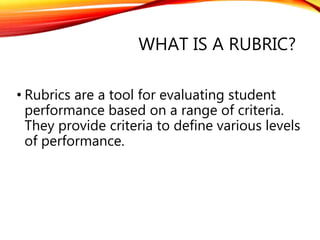Tamu rubric tips
- 1. USING RUBRICS TAMU Faculty Orientation
- 2. WHAT IS A RUBRIC? • Rubrics are a tool for evaluating student performance based on a range of criteria. They provide criteria to define various levels of performance.
- 3. RUBRICS ALSO • Define elements of the learning task and then describe quality levels of performance.
- 4. ADVANTAGES OF USING RUBRICS • Well-written rubrics help clarify the teacher’s expectations • Rubrics help keep the grading process consistent • Rubrics help reduce the subjectivity inherent in grading subjective assessments
- 5. RUBRICS ALSO • Can help to speed up the grading process by keeping the grader on task. • Can help students to review and revise assignments and promote reflective learning.
- 6. 1. DEFINE THE PURPOSE OF THE ASSESSMENT Questions to consider: • Will you use the rubric to assign a grade? • Will you use the rubric to give feedback so students can improve their performance? • Is the rubric for a multi-dimensional project or for a simple, straight-forward assignment? • What are the learning outcomes? • How will students demonstrate they've learned these outcomes?
- 7. 2. ESTABLISH CRITERIA Criteria emphasize instructional priorities. This focuses students’ attention on specific parts of an assignment. • What should be learned? • How will students demonstrate that they have learned? • What knowledge, skills, and behavior are required for the task? • What steps are required for the task? • What are the characteristics of the final product?
- 8. 3. ESTABLISH A RATING SCALE More rating points provide more detail, but can make it more difficult to delineate differences between each point. Examples include: • Meets or does not meet the standard • Unsatisfactory, satisfactory • Below/meets/exceeds expectations • Never, sometimes, usually, or always • Limited, acceptable, or proficient • Poor, fair, good, excellent, superior
- 9. 4. WRITE PERFORMANCE DESCRIPTORS Write performance descriptors for each scale point. Descriptors should: • Describe observable and measurable behavior • Written in consistent and parallel language across the scale. • Indicate the degree to which the standards are met. • The behavior may vary in degree through amount, frequency, or intensity.
- 10. SAMPLE RUBRIC









